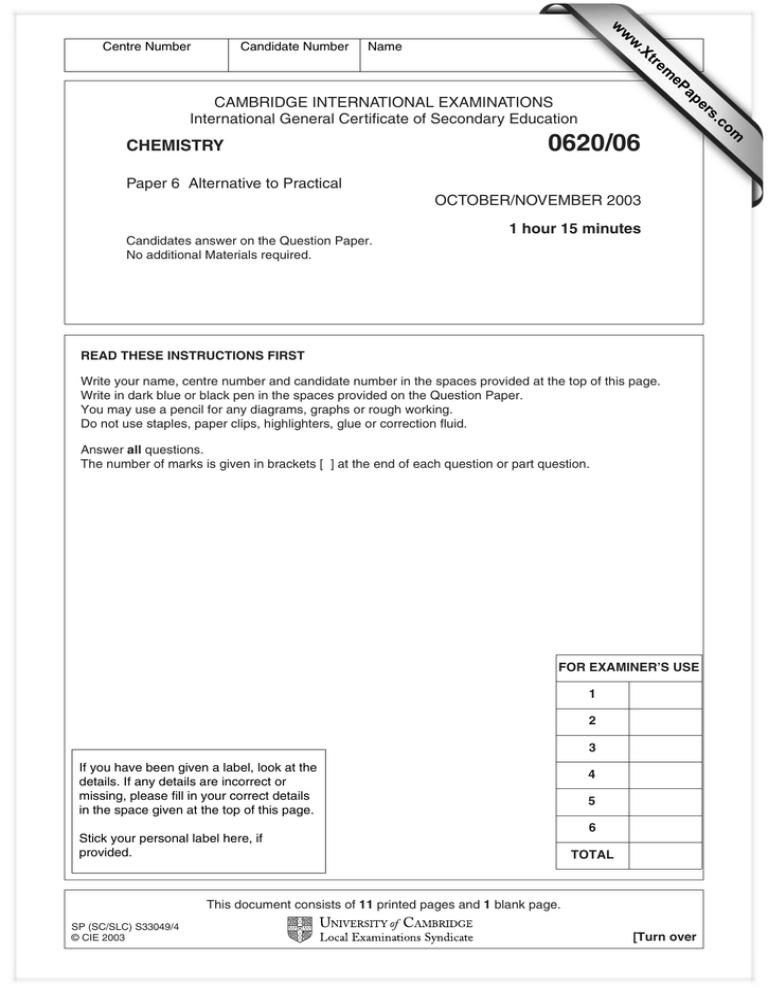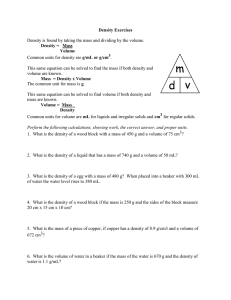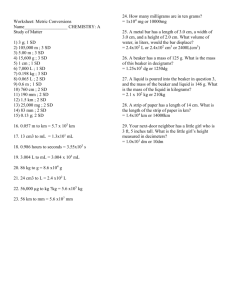0620/06 CHEMISTRY
advertisement

w w Name ap eP m e tr .X Candidate Number w Centre Number 0620/06 Paper 6 Alternative to Practical OCTOBER/NOVEMBER 2003 1 hour 15 minutes Candidates answer on the Question Paper. No additional Materials required. READ THESE INSTRUCTIONS FIRST Write your name, centre number and candidate number in the spaces provided at the top of this page. Write in dark blue or black pen in the spaces provided on the Question Paper. You may use a pencil for any diagrams, graphs or rough working. Do not use staples, paper clips, highlighters, glue or correction fluid. Answer all questions. The number of marks is given in brackets [ ] at the end of each question or part question. FOR EXAMINER’S USE 1 2 3 If you have been given a label, look at the details. If any details are incorrect or missing, please fill in your correct details in the space given at the top of this page. Stick your personal label here, if provided. 4 5 6 TOTAL This document consists of 11 printed pages and 1 blank page. SP (SC/SLC) S33049/4 © CIE 2003 [Turn over om .c CHEMISTRY s er CAMBRIDGE INTERNATIONAL EXAMINATIONS International General Certificate of Secondary Education 2 1 For Examiner’s Use The apparatus below was used to separate ethanol from water. (a) Complete the empty boxes to name the pieces of apparatus. [3] (b) Indicate by an arrow where heat is applied. [1] (c) Name this separation process. ......................................................................................................................................[2] 0620/06 O/N/03 3 2 A student extracted and investigated the orange colour in some sweets. The student followed these instructions: 1 Collect sweets, a watch glass, a beaker, eye protection and 100 cm3 of ethanol. 2 Crush the sweets. 3 Place the crushed sweets in the beaker containing 100 cm3 of ethanol. 4 Boil the mixture with the watch glass covering the beaker. 5 Decant the liquid and concentrate it by evaporation until the colour is dark orange. 6 Investigate which colours are present in the orange solution. For Examiner’s Use (a) Why should the sweets be crushed? .......................................................................................................................................... ......................................................................................................................................[2] (b) Why should the experiment be carried out in a well-ventilated laboratory? ......................................................................................................................................[1] (c) State one safety precaution that the student should have taken, other than carrying out the experiment in a well-ventilated laboratory and using eye protection. ......................................................................................................................................[1] (d) State the purpose of the watch glass. ......................................................................................................................................[1] (e) Explain the term decant. ......................................................................................................................................[1] (f) Describe how the student could carry out instruction 6. You may draw a diagram in the space below to help you answer the question. .......................................................................................................................................... .......................................................................................................................................... .......................................................................................................................................... .......................................................................................................................................... ......................................................................................................................................[5] 0620/06 O/N/03 [Turn over 4 3 A student investigated the speed of reaction between aqueous potassium bromate and potassium iodide solution. A burette was filled up to the 0.0 cm3 mark with aqueous potassium iodide. To each of 5 test-tubes was added 6 cm3 of aqueous potassium iodide to be used in the 5 following experiments. Experiment 1 By using a measuring cylinder 12 cm3 of aqueous potassium bromate was poured into a small beaker. To this solution was added 4 cm3 of water, 2 cm3 of hydrochloric acid, 5 cm3 of starch solution and 1 cm3 of sodium thiosulphate solution. The beaker was placed on a cross drawn on a piece of paper. From one of the test-tubes 6 cm3 of aqueous potassium iodide was added to the mixture in the beaker and the timer started. A dark blue colour formed. The timer was stopped when the cross on the paper could not be seen. Use the stop clock diagram to record the time in the table. Experiment 2 By using a measuring cylinder 10 cm3 of potassium bromate solution was poured into a beaker. The instructions were repeated exactly as given for Experiment 1, but 6 cm3 of water was added to the beaker. Use the diagram to record the time in the table. Experiments 3, 4 and 5 Experiment 1 was repeated using the volumes of aqueous potassium bromate and water specified in the table of results. Record the times in the table. 0620/06 O/N/03 For Examiner’s Use 5 For Examiner’s Use Table of results Experiment volume clock diagram potassium bromate/cm3 water/cm3 1 12 4 minutes 0 time/s seconds 0 45 15 5 15 10 30 minutes 0 seconds 0 2 10 6 45 15 5 15 10 30 minutes 0 seconds 0 3 8 8 45 15 5 15 10 30 minutes 0 seconds 0 4 6 10 45 15 5 15 10 30 minutes 0 seconds 0 5 4 12 45 15 5 15 10 30 0620/06 O/N/03 [5] [Turn over 6 For Examiner’s Use (a) Plot the results on the grid. Draw a smooth line graph. 12 10 8 volume of potassium bromate / cm3 6 4 2 0 20 60 40 time / s 80 100 [4] (b) From your graph estimate the time of the reaction if Experiment 1 was repeated using 5 cm3 of potassium bromate and 11 cm3 of water. .......................................................................................................................................... Show clearly on your graph how you worked out your answers. (c) (i) [3] Which experiment is the quickest? ................................................................................................................................... (ii) Explain why this experiment is the quickest. ................................................................................................................................... ................................................................................................................................... ...............................................................................................................................[3] 0620/06 O/N/03 7 (d) (i) For Examiner’s Use State two possible sources of error in the experiments. 1 ................................................................................................................................ ................................................................................................................................... 2 ................................................................................................................................ ................................................................................................................................... (ii) Suggest two improvements to reduce the sources of error in the experiments. 1 ................................................................................................................................ ................................................................................................................................... 2 ................................................................................................................................ ...............................................................................................................................[4] 0620/06 O/N/03 [Turn over 8 4 An aqueous solution of substance X was analysed. Substance X was an iron(III) salt containing one other cation. The tests on X and some of the observations are in the following table. Complete the observations in the table. Tests Observations (a) Colour of solution X (b) (i) Drops of aqueous sodium hydroxide were added to about 2 cm3 of the solution. Excess aqueous sodium hydroxide was added to the test-tube. dark yellow ................................................................................ ................................................................................ ............................................................................[3] (ii) The mixture was heated. The gas given off was tested with damp indicator paper. pungent smell indicator turned blue, pH 10 (c) Experiment (b)(i) was repeated using aqueous ammonia instead of aqueous sodium hydroxide. ................................................................................ ................................................................................ ............................................................................[2] (d) To about 2 cm3 of solution X was added dilute sulphuric acid. Two pieces of zinc were added. The mixture was heated and the gas given off tested. lighted splint popped After 10 minutes the mixture was filtered and test (b)(i) was repeated. green precipitate insoluble in excess (e) A few drops of hydrochloric acid were added to about 2 cm3 of solution X. About 1 cm3 of barium chloride solution was added to the mixture. white precipitate 0620/06 O/N/03 For Examiner’s Use 9 (f) (i) For Examiner’s Use Name the gas given off in (d). ................................................................................................................................... (ii) What type of chemical reaction occurs in (d). Explain your answer. ................................................................................................................................... ..................................................................................................................................[3] (g) What conclusions can you draw about the anion and the other cation in substance X? anion ................................................................................................................................ cation ............................................................................................................................[2] 0620/06 O/N/03 [Turn over 10 5 Ammonia is produced when aqueous sodium hydroxide is warmed with ammonium sulphate. Ammonia is less dense than air and very soluble in water. The apparatus below was used to prepare a sample of dry ammonia gas. C ammonia D concentrated sulphuric acid (a) Name substance C. ......................................................................................................[1] (b) Name substance D. ......................................................................................................[1] (c) What necessary piece of equipment is missing in the diagram? ......................................................................................................................................[1] (d) Suggest why concentrated sulphuric acid should not be used to dry ammonia. ......................................................................................................................................[1] (e) There are two other mistakes in the apparatus shown in the diagram. Identify and explain these mistakes. mistake 1 .......................................................................................................................... explanation ....................................................................................................................... mistake 2 .......................................................................................................................... explanation ...................................................................................................................[4] 0620/06 O/N/03 For Examiner’s Use 11 6 Sulphur dioxide gas is a common pollutant formed when fossil fuels burn in air. Sulphur dioxide can be detected by using an acidic solution of potassium dichromate(VI). The dichromate solution changes colour from orange to green when a certain amount of sulphur dioxide has reacted with it. Plan an experiment to investigate which of three different samples of coal produces most sulphur dioxide. .................................................................................................................................................. .................................................................................................................................................. .................................................................................................................................................. .................................................................................................................................................. .................................................................................................................................................. .................................................................................................................................................. .................................................................................................................................................. ..............................................................................................................................................[6] 0620/06 O/N/03 For Examiner’s Use 12 BLANK PAGE 0620/06 O/N/03





